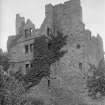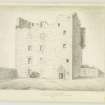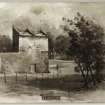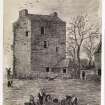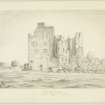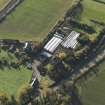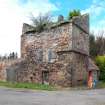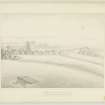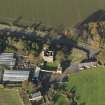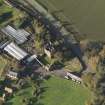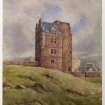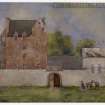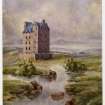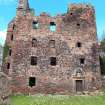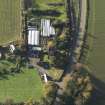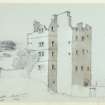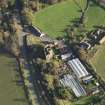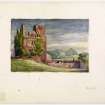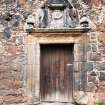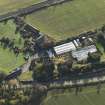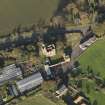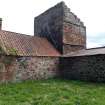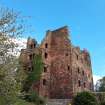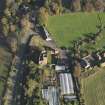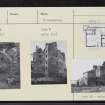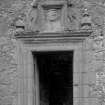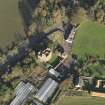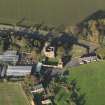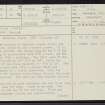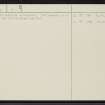Redhouse Castle
Tower House (Medieval)
Site Name Redhouse Castle
Classification Tower House (Medieval)
Alternative Name(s) Red Castle; Reid Spittal
Canmore ID 54877
Site Number NT47NE 2
NGR NT 46264 77070
Datum OSGB36 - NGR
Permalink http://canmore.org.uk/site/54877
- Council East Lothian
- Parish Aberlady
- Former Region Lothian
- Former District East Lothian
- Former County East Lothian
NT47NE 2.00 NT 46264 77070
NT47NE 2.01 NT 461 770 Garden
NT47NE 2.02 NT 46374 77126 Redhouse Lodge
NT47NE 2.03 NT 46271 77003 Redhouse (Farmhouse)
NT47NE 2.04 NT 46286 77052 Dovecot
NT47NE 134 NT 46333 77080 1 Redhouse Cottage
NT47NE 157 NT 46324 77077 2 Redhouse Cottage
NT47NE 158 NT 46317 77072 3 Redhouse Cottage
(NT 4626 7706) Redhouse Castle (NR) (remains of)
OS 6" map (1968)
The ruined mansion of Redhouse stands within the walls of its park, which is now a market garden. It is of at least two periods, the oblong wing on the N of the courtyard being of approximate late 16th c date, and the rest is an early 17th c addition. The total area of the mansion and courtyard is 100' N-S by 106', while the oldest portion of the house measures 22' N-S by 45'. The courtyard has a wide late 16th c gateway which was probably surmounted by a little gatehouse. Only the southernmost of the eastern outbuildings retains its upper storey, now a dovecot. The rest are only vaulted cellars.
RCAHMS 1924
The remains are in good condition and are 15.0m long, 10.0m wide and some 36' high. There is no roof. Two staircases run to the top of the building. There are several well-preserved windows and crenellations.
OS Reviser 9 October 1953
No change to previous information. The dovecot is at NT 4628 7705.
Visited by OS (RDL) 25 October 1962 and (BS) 14 October 1975
Repair and stabilising work carried out on the castle from 1991 to 1994 under the supervision of architect A G Giffen for Wemyss and March Estate, after reports on the deteriorating condition by Historic Scotland.
A G Giffen 1995.
NT47NE 2.00 46264 77070
NMRS REFERENCE:
Late 16th century with L. shaped early 17th century addition to castle enclosing courtyard. Demolished c. 1758.
Field Visit (23 March 1920)
On a rocky knoll immediately south of the road from Longniddry to Drem and 1 ¼ miles E.N.E. of Longniddry Station, the ruined mansion of Redhouse stands within the walls of its park, which is now a market garden. The house forms the northern side of a quadrangular courtyard (fig. 38) that is bounded on the east by a range of outbuilding and on the south and west by boundary walls.
The courtyard is entered from the south (fig.39) through a wide gateway (late 16th century), with a semi-circular head round which returns a roll-and-hollow moulding that continues down the jambs; the detail of the moulding indicates that the wall, which is built of rubble, was harled. Over the gateway five projecting corbels suggest that the entrance was surmounted by a little gatehouse, as at Hills Castle, Kirkcudbrightshire, [RCAHMS] Kirkc. Inventory, No. 330, which projected outwardly on the corbels and was borne on the sturdy segmental scoinson arch. The eastern outbuildings consist of a range of vaulted cellars with, formerly, an upper storey within a very steeply pitched roof. Two of the cellars retain their barrel vaulted ceilings, but the timber roof above has been reconstructed with a less acute pitch, making the range one-storeyed. The southern cellar, however, still retains its upper storey, which is two chambered and is the dove-cot; each of these chambers was entered from a doorway in the south wall reached by a movable ladder, but the western door had been built up and an access latterly formed in the mid-partition between the two chambers. The nests are of stone, as is usual. The stone roof is constructed with a continuous corbel-table projecting inwardly from the north and south walls and surmounted by flagstones cantilevered until the void is spanned, but the usual circular opening for ingress and egress of the birds is left. Around the south, east and west walls an unmoulded stringcourse and a cavetto moulded eaves course return; the gables are stepped. The doorway in the west wall of the courtyard and that of the cellarage of the east range have good Scotch renaissance moulded architraves c. 17th century.
The house is of at least two periods, but no great length of time has intervened between these. To the earlier period (c. late 16th century) may be ascribed the oblong wing fronting the courtyard on the north, while the remainder of the building is evidently an early17th century addition. This is L-shaped and lies north of the original portion (fig. 40).
Throughout, the walling is of warm coloured rubble partially of freestone; the lower and all the earlier windows have dressed and rounded jambs and lintels, half grooved for glazing. The later windows on the upper floors, the south doorway, the string courses on the north and west fronts and the corbelling of the angle turrets which project from the north-west and north-east angles and the north-east re-entering angle are of dressed and moulded light coloured freestone.
The south front is four storeys in height to the wall-head, above which was an attic lit by dormer windows, but the walls at the southeast angle are carried higher, providing apartments over the wheel-stair. The north front is more richly treated; a moulded string course returns at the level of the turret upper corbel courses and a second at attic floor level. The corbelling of the north-west turret has numerous and delicate members, while that of the others is simple and massive, yet the turrets have undoubtedly been built at the same time c.1600.
The ground being higher on the north, the north doorway enters the building at first floor level and a scale staircase leads down to the apartments at courtyard level. The detail of the west elevation is similar to that of the north frontage. The two-light dormer window on this elevation is worthy of note. It has moulded jambs and a triangular pediment with raking cornice. In the tympanum is a weatherworn shield flanked by the initials R. D. On a skewput immediately to the south are the initials M. I. L. These are for Master John Laing and Rebecca Dennistoun, his wife (1).
From the east gable of the house a range of outbuilding with vaulted cellars on the basement floor returned eastward and abutted on the eastern range. These are represented only by the lower courses of the north wall.
The building is to-day entered through the fine Renaissance doorway on the south (fig.41), which has moulded jambs, lintel and cornice. On the lintel is carved in raised letters MIL NISI . DOMINVS . FRUSTRA . R D with a cinquefoil balancing the two first initials. The initials have been explained above. At either end of the cornice is a lumpy finial, which flanks a moulded panel space supported by trusses; the panel is greatly destroyed and appears to be inverted; the charge is three piles conjoined in point. Above the panel is a raking and broken cornice with a mid-finial; in the tympanum are repeated the initials M I L R D, the first three in monogram and flanked by the other two. The doorway enters at the foot of a wide wheel-stair, behind which, on the north, is a small chamber, and on the west the kitchen with large fireplace and flue in the west gable and an aumbry recess in the north jamb of the fireplace. North of the kitchen is a gallery with a barrel-vaulted roof lit by shafts in the north haunch of the vault, and on the west a scale stair leads down from the north entrance to the kitchen level; beneath the stair is a vaulted cellar. A similar arrangement of apartments is found on each of the floors. It is worth noting that only the three lower floors of the north gallery and the cellar under the stair are vaulted; the remaining apartments have been ceiled in wood. The support of the scoinson arches of the two-light window on the second floor of the west wing by a heavy corbel is characteristically Scottish. The walls internally have been plastered ‘on the hard’.
DIMENSIONS. The total area covered by the mansion and its courtyard measures 100 feet from N. to S. by 106 feet from E. to W. The oldest portion of the house measures 22 feet from N. to S. by 45 feet from E. to W. The building is in a very ruinous state and urgently requires attention.
FIREPLACE. Within the neighbouring house of the tenant is a fine 17th century fireplace with moulded jambs arid lintel, the outer moulding being enriched with a curious and rudimentary egg-and-dart ornament. The fireplace is stated to have been removed from Redhouse, but the fireplaces there are quite unlike this example, having merely rounded jambs and lintels, and in any case seem complete.
HISTORICAL NOTE. The lands of ‘Eister Spittell’ or ‘Eister Reidspittell’ or Redhouse came to John Laing, keeper of the royal signet and Rebecca Dennistoun his spouse, by purchase from the superior David Lindsay of Balcarres at the instigation and with the consent of Sir George Douglas of Redhouse and his heir; the royal confirmation to the charter is dated 1607. In 1612 there is a ratification of an instrument of sasine granted in 1608 by the late John Laing of ‘Spittellis’ conferring the property on Sir Andrew Hamilton of Redhouse and Lady Jeanne Layng his wife, daughter and heiress of John Laing, Hamilton being a judge or II senator of the Supreme Court." In I62I a charter of novodamus of the lands of Easter Spittal otherwise Easter Redspittal II with the manor (called Redhouse)"erected the whole estate into the free barony of Reidhouse and single sasine was givenapud turrim et maneriem de Reidhouse (1).
RCAHMS 1924, visited 23 March 1920.
(1) Reg. Mag. Sig. s.a. Nos. I990, 778, 204.













































